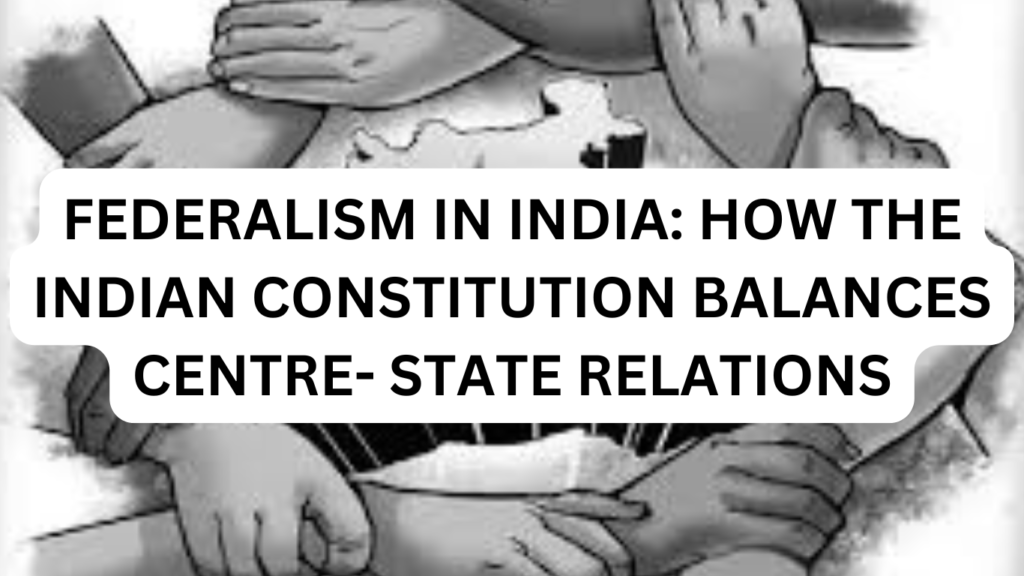
“The constitution establishes a federal structure that maintains the duality of power between the centre and the states,ensuring that the nation remains a single entity while respecting local autonomy” –B.R AMBEDKAR
ABSTRACT
With all humility we would venture to state that this digression was not only unnecessary and irrelevant but misleading for federalism in India is founded ,not on the ‘rule of law’ but on supremacy of written constitution. India is a member of the family of federations of which the better known members are USA, Canada, Australia . Indian federalism has been designed after a close and careful study of contemporary trends in these federations. The idea behind federalism in India is to create a governance structure that balances the need for national unity with respect for regional diversity. It establishes dual policy, a two tier government system with the central government at one level and the state government on the other. The constitution marks off the sphere of action of each level of government by dividing an elaborate scheme of distribution of legislative ,administrative and financial power between the centre and the state. The government is entitled to act within its assigned field and cannot go out of it,on encroach on fields assigned to other governments.
This arrangement aims to accommodate India’s vast cultural ,linguistic and regional differences while ensuring effective governance by delineating powers through a clear division of responsibility ,federalism seeks to promote local autonomy and representation ,fostering a sense of inclusivity and stability within a nation.
MEANING
Federalism is a system of government in which power is divided between centre and state. Both authorities have their own areas of authority to govern and they operate independently of each other in those area.federalism allows for balance between unity and regional autonomy enabling different regions to have control over certain local matters while being part of a larger ,unified country.
HISTORICAL BACKGROUND OF FEDERALISM IN INDIA
The historical roots of federalism in india can be traced back to various influences including colonial governance,regional aspirations and constitutional developments:
- Pre-colonial and colonial periods:
Before British rule ,India had multitude of regional kingdoms and empires and each with its own administratives systems .While these were not federal in nature they showcased a form of regional autonomy where local rules had significant power.
- British colonial rule:
The British centralised form of government which aims to consolidate power. The government of india act 1919 introduced a system of dyarchy ,allowing limited self governance in provinces which lead to groundwork for future federal arrangements .this act recognizes the importance of provincial governance and need for regional.
- The government of india act 1935:
This act pivotal moment in evolution of federalism in india , it include
- A division of powers between centre and provinces with federal list ,provincial list,concurrent list.
- The introduction of provincial autonomy provinces to have more control over local matters .
- Independence and the constitutional assembly:
Following the indian independence in1947 there is need to federal framework which lead to
- Debated on federalism :leaders like B R Ambedkar ,Sardar vallabhai patel JAWAHARLAL NEHRUstrongly debated on balance between central and state.
- Adoption of constitution: constitution adoption enshrined quasi federal structure .There is division of three lists which states function of this authority.
- Post independence developments:
- Reorganisation of states: this act 1956 bright reorganised states based on linguistic and cultural lines,strengthening federal fabric by acknowledging regional identities.
- Emergency provisions: the constitutional provisions are related to allow the centre to assume greater control during emergencies ,reflecting pragmatic approach to governance in times of crisis.
- Cooperative federalism:this federalism brought guiding principles to demonstrate collaborative governance between central and state.
EVOLVING NATURE OF INDIAN FEDERALISM
Indian federalism has evolved to meet changing political , economic and social needs of the country:
- Cooperative federalism: with initiatives like GST and ayushman bharta the centre and state are increasingly cooperating to implement policies of national importance.
- Competitive federalism:states now compete to attract investment ,improve governance and implement reforms ,promoting economic growth and innovation.
Despite all this positive tends tension between the central and state continue in case of political ,financial ,administrative issues
ESSENTIAL FEATURES OF FEDERAL POLITY
There is lot of views by scholars on essential of federalism in india therefore some of this involved are :
- Dual government:In federal state there is distribution of power between state and central both exercised only such power as from time to time delegated to them by the national government and it is completed for the national government to revoke the delegate powers or any of them at its will.
- Distribution of powers:It follows that every object for which a federal state is formed involves a division of authority between the federal government and states though the method of distribution may not be alike in federal constitutions.
- Supremacy of the constitution:A federal state derives its existences from constitution just as a corporation derives its existence from the grant of statue by which it is created .every power -executive,legislative or judicial-whether it belongs to federation or to components states it subordinate to and controlled by the constitution.
- Authority of courts :In the federal state the legal supremacy of the constitution is essential to the existence of the federal system .It is essential to maintain the division of power not only between the coordinate branches of the government but also between federal government and the states themselves. This is secured by vesting in the courts as final power to interpret the constitutional and nullify an action on the action of federal and the state government or their different organs which violates the provision of the constitutions.
WHAT ARE THE SIGNIFICANCE OF INDIAN FEDERALISM ?
Indian federalism is significant for several reason:
- Accommodation of diversity: federalism in india allow the accommodation of diversity by giving autonomy to states to govern their state affairs and address their need and concerns
- Effective governance: federalism in India ensures the place to deliver effective governance and to ensure that diverse needs and interests of states are represented in the decision making process.
- Promotion of democracy:federalism promotes democracy by ensuring that power is decentralised and shared between different levels of government.
- Protection of rights: to address the speedy needs and concern of their diverse population federalism allows more robust protection of rights and minor rights to state government.
CONSTITUTIONAL FRAMEWORK
The Indian constitution provides for a good deal of centralisation .The central government has a large sphere of action and thus plays a more domain role than the states . the constitution enshrines the principles of federalism primarily in its division between the union and state government.this division is outlined in three lists provide in the seventh schedules:
- Union list: list include subjects of national importance such as defence, foreign affairs and atomic energy over which the central government has exclusive powers.
- State list : list include areas of local significance such as police, public ,health, the culture where states have the authority to legislate.
- Concurrent list: subjects like education, marriage and trade which can be legislated by both the central and states , fall under this category .In case of conflict the central law prevails.
- Article 245:Specific the territorial limits within which the parliaments and state legislature can exercise their powers.
- Article 246:Establishes parliament’s authority to legislate on subjects in the union and concurrent list while the state legislature holds power over the state list.
- Article 256-263:Focuses on administrative relations between the union and the states including cooperation and coordination between both entities.
- Article 356(president’s rule) :Allows the central government to take direct control of the state government under certain circumstances like failure of constitutional machinery in state.
The emergency provisions provide a simple way of transforming the normal federal fabric into an almost unitary system so as to meet national emergency effectively.
DISTRIBUTION OF POWERS
The constitution employs mechanism to ensure dynamic balance between the centre and states:
- Financial relation The financial commission plays an important role in distributing financial resources between the state and central and ensuring that these states have adequate funding development while maintaining the provision related to is mentioned in article 268 to 293 .Union power of taxation including income tax (excluding agricultural income),customs duties and excises duties and corporations taxes. States have power to levy taxes on subjects within their jurisdiction such as land , agricultural income and state taxes .
- Administrative relations The constitutional provide provision related to administrative matter under article 256, 258,263 which stated that:
- Article 256 stated that state are required to comply with laws made by parliament and ensure proper implementation
- Article 258 allows the president to delegate union powers to state governments, facilitating corporations on overlapping issues.
- Article 263 provides for establishment of inter state councils to resolve disputes and ensure coordination between states and centre.
- Emergency provision: Emergency provision is granted to the centre allowing it to override state autonomy in certain situations. Provision related to emergency is article 352 -360 of constitution of india
- Article 352 steed that president can declare national energy during war , external aggression, armed rebellion during which union government assumes greater control over state matters
- Article 356 stated that if state government is unable to function according to provision of constitution, president can impose direct control by dismissing state legislature and government
- Article 360 stated that in case of the threat to indian ‘s financial stability the central can assume more financial control over the states
CHALLENGES TO FEDERALISM IN INDIA
Indian federalism faces significant challenges i.e
- There is concern about increasing the centralising dominance power especially in areas traditionally governed by state autonomy .
- The relationship between the central and state is influenced by political factors , disparities in political power can lead to conflict with opposite ruled states feeling marginalised by the central government.
- There is dispute between the central and state on sharing inter state relation issues i.e water sharing,border issues, resources allocation can create friction between states ,complicating the federal balance
- Economic and developmental inequalities among states can fuel discontent and calls for greater autonomy posing threat to federal structure.
JUDICIAL INTERPRETATIONS AND ROLE OF THE COURTS
The supreme court and high courts plays critical role in maintaining the federal balance by interpreting constitution and resolving disputes between centre and states .some of landmark judgement highlighted federal character of constitution and also clarify limits of legislative and executive powers and thereby reinforcing federal principles ;
- R Bommai vs union of india (1994)[1]
The supreme court underscored the importance of federalism: “the federal structure is a basic feature of the constitution ,the central government must respect the autonomy of the states,especially concerning their legislative powers”
- Kesavananda bharati vs state of kerala(1973)[2]
This case affirmed the basic structure doctrine highlighting the role of federalism: “the constitution is not a mere legal document it embodies the essence of federalism which is integral to its identity and must be preserve”
Such an interpretation ,the judiciary ensured that neither central nor the states exceed their constitutional boundaries ,preserving the federal structure.
CONCLUSION
Federalism in India is a dynamic system that balances central and state power ,reflecting the country ‘s diverse needs and aspirations.the constitution provides a solid framework for this balance ,incorporating mechanisms for financial relation and administration and economic relations.
REFERENCES
- BOOKS:
- INDIAN CONSTITUTION LAW (EIGHTH EDITION) M P JAIN
- INTRODUCTION TO THE CONSTITUTION OF INDIA- D.D BASU’S
- COMPARATIVE CONSTITUTIONAL LAW (REVISED EDITION) LEXISNEXIS
- JUDICIAL INTERPRETATION
- R BOMMAI VS UNION OF INDIA(1994)
- KESAVANANDA BHARATI VS STATE OF KERALA(1973)
- REPORTS
- REPORTS OF FINANCE COMMISSION OF INDIA
- SECOND ADMINISTRATIVE REFORMS COMMISSION REPORTS(2009)
- ONLINE SOURCES
- https://blog.ipleaders.in/
- https://vajiramandravi.com/
- https://www.indianscholar.co.in/
[1] 1994 AIR 1918, 1994 SCC (3) 1
[2] AIR 1973 SUPREME COURT 1461, 1973 4 SCC 225, and Writ Petition (civil) 135 of 1970.
This article has been written by Kamna katiyar, 9TH SEM RAMA UNIVERSITY KANPUR.






